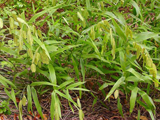Native Plants

Q. Who is Mr. Smarty Plants?
A: There are those who suspect Wildflower Center volunteers are the culpable and capable culprits. Yet, others think staff members play some, albeit small, role. You can torture us with your plant questions, but we will never reveal the Green Guru's secret identity.
Did you know you can access the Native Plant Information Network with your web-enabled smartphone?
Ask Mr. Smarty Plants is a free service provided by the staff and volunteers at the Lady Bird Johnson Wildflower Center.

rate this answer
Monday - June 18, 2012
From: Leander, TX
Region: Southwest
Topic: Xeriscapes, Drought Tolerant, Groundcovers, Shade Tolerant, Grasses or Grass-like, Herbs/Forbs
Title: Ground cover under live oaks
Answered by: Guy Thompson
QUESTION:
I have some areas under Live Oak trees (maybe 200 sq. ft.)that remain bare, in spite of trying Habiturf. Soil is dry, poor and shallow. Can you suggest a living ground cover that would not require major rework of the soil?ANSWER:
I have had the same experience as you, except my bare ground is under deciduous oaks, Quercus texana (Nuttall oak). I am experimenting with several native plants that will survive drought. I'm having pretty good luck with Calyptocarpus vialis (Straggler daisy), Carex planostachys (Cedar sedge), Salvia lyrata (Lyreleaf sage), and Paspalum setaceum (Thin paspalum). Some of the other sedges, such as Carex texensis (Texas sedge) and Carex amphibola (Creek sedge) might do well, although they might need slightly more water than Habiturf. These are all mowable at a height of about four inches. The first four species are common around suburban Central Texas, and I simply transplanted some from other spots in my yard. I also tried Tridens muticus (Slim tridens), but it seems too coarse for a lawn. If a taller grass will fit in, try Chasmanthium latifolium (Inland sea oats), which grows to about two feet in height and does very well in shade.
Images of some of my suggested species are shown below.
From the Image Gallery
More Grasses or Grass-like Questions
Erosion Control for Salem IN
September 02, 2014 - We've recently had a new pond dug. It is on a hill side and has some very steep and tall banks. We were advised that our best chance of keeping soil from eroding was to plant fescue. I'm not thrille...
view the full question and answer
Identification of red-topped grass blooming in Comal County
May 21, 2013 - I live in Comal County and right now (mid May) there is a beautiful, red topped grass growing along the side of country roads. It is maybe 1 foot tall, and waves in the breeze. Do you know what kind o...
view the full question and answer
Non-native smoketree for California City, CA
June 28, 2010 - I was wondering if you could tell me if it would be a good or bad idea to plant a Smoke Tree (most likely European) in the vicinity of a septic tank. We are looking for something which will provide a...
view the full question and answer
Hillside Erosion in Pace FL
July 17, 2015 - I have a hillside that slopes down about 10 feet to a spring fed pond. The pond drains into Escambia Bay. We have 2 dams with culverts to control the flow of water. Last year during a torrential ra...
view the full question and answer
Plants to replace Phragmites australis (Common reed) in Cedar Ridge Preserve
February 25, 2015 - Dear Mr. Smarty Plants,
I live in the DFW area and volunteer at a preserve (Cedar Ridge). We are constantly battling the common reed, Phragmites australis, around the pond. I am wondering what shou...
view the full question and answer
| Support the Wildflower Center by Donating Online or Becoming a Member today. |

